By Alisha Roemeling
The Register-Guard
Published on Filed Under : District News Published by: Nathan Bowers

65 South Pioneer St. Lowell, OR 97452
Map it45 S Moss StreetLowell, OR 97452
Phone: (541) 937-2105Fax: (541) 937-8709
65 S Pioneer StreetLowell, OR 97452
Phone: (541) 937-2124Fax: (541) 937-2112
